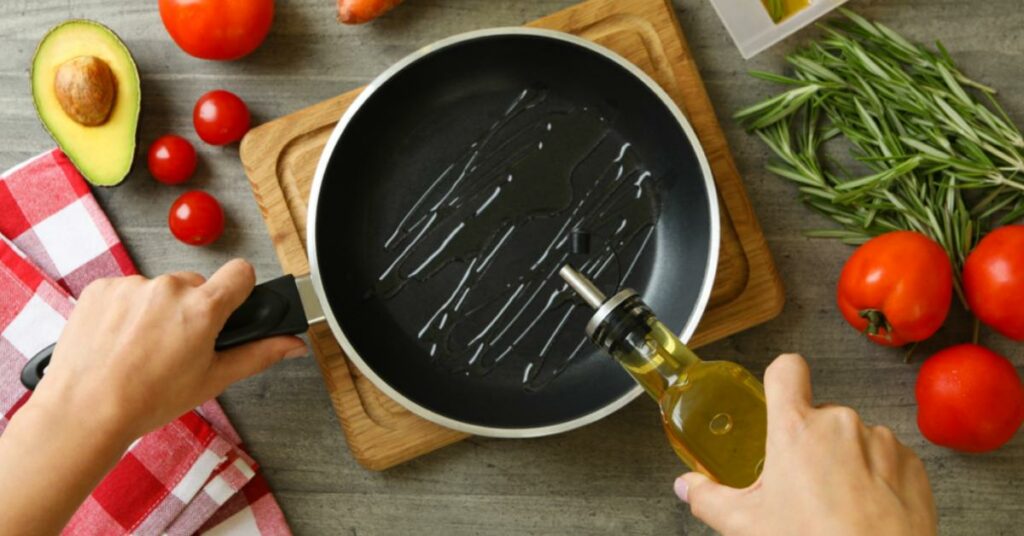Cooking oil is derived from plants, animals that are used in frying, baking, and other forms of cooking. It’s also used in food preparation and flavoring that doesn’t involve heat, such as salad dressings and bread dips.
What is the taste of cooking oil? The truth is, there are many different types of cooking oil, and each one has its unique flavor. Plain vegetable oil for frying or baking is fairly tasteless, but unrefined oils from different seeds or nuts can offer a significant pon of the flavor of a dish.
In this blog post, we will know about the different flavors that you can expect from common cooking oils.

Factors That Affect the Taste of Oil
The taste of cooking oil can be affected by a variety of factors. The type of oil, the age of the oil, and how it is stored all play a role in determining its flavor.
In general, oils that are high in monounsaturated fats or polyunsaturated fats tend to have a milder flavor than those that are high in saturated fats. Oils that are made from vegetables or nuts tend to have a milder flavor than those that are made from animal fats.
The age of the oil can also affect its taste. Oils that have been stored for a long time will often be darker in color and have a stronger flavor than fresh oils.
Oils that have been stored in the refrigerator or freezer will also tend to be darker and stronger tasting than oils that are kept at room temperature. If you are concerned about the taste of your cooking oil, try storing it somewhere else like a pantry or cabinet away from strong smells.
The taste of cooking oil can also be affected by the way it is used. Oils that are heated to a high temperature will often have a stronger flavor than those that are cooked at a lower temperature.
LEARN MORE: Can You Use Silicone Tongs In Cooking Oil?
Types of Cooking Oil and Their Tastes
Here is a list of some common cooking oils and their corresponding tastes:
Extra-virgin Olive Oil: An unrefined oil with a strong olive flavor, fruity, peppery flavor that is ideal for salads and light cooking.
Soybean Oil: It is one of the most commonly used oil in the world. Because soybean oil has little flavor, you may use it knowing that the finished product will not be altered.
Canola oil: It has a flavor that is not distinctive and is difficult to detect in baked goods. It’s also high in oleic acid, which can help keep you full longer.
Sesame oil: This oil has a strong, toasty and nutty flavor that is good for cooking Asian food. Oil derived from toasted nuts enhances and intensifies the taste.
Peanut oil: This oil has a nutty, slightly sweet flavor that is good for cooking various types of foods. Cooking with it can make your food smell like peanuts.
Coconut oil: This oil has a strong, tropical flavor that is good for cooking savory dishes and fish dishes. also good for baking.
Butter: Derived from milk, this oil has a rich, soft and creamy flavor that is perfect for making desserts or sautéing vegetables.
Sunflower oil: The flavor, odor, and some of the color are removed during the refining process. It also removes part of its nutrients. The taste of unrefined sunflower oil is similar to that of sunflower seeds (drum roll).
Corn oil: At room temperature, corn oil imparts a subtle roasted corn flavor to dishes prepared with it.
Avocado oil: Avocado oil has a milder flavor than that of actual avocado. It has a nutty-fruity flavor profile and is nutty to grassy than other varieties.
LEARN MORE: Is Cooking With Edible Oil Good for Health?
Flavored and Infused Oils
You can blend cooking oil with other flavors to create flavored cooking oils. These types of cooking oils are good for cooking and dipping bread, adding flavor to salads dressing, or as a condiment.
Infused oils are cooking oils that have been blended with herbs, spices, garlic or chili peppers. Infusing oil is very easy to do.
You can make cooking oils with any combination of herbs, spices and flavors to create your own unique cooking oil. the method of infusing oil is very simple. just place the ingredients in a jar and let it sit for at least two weeks.
Some popular combinations include:
Garlic and herb oil: This cooking oil has a strong, pungent garlic flavor that is great for cooking Italian food or adding to salad dressings.
Chili pepper and lime oil: This cooking oil has a hot, spicy taste that is good for cooking Mexican food or adding to salad dressings.
Lemon and thyme cooking oil: This cooking oil has a light, citrus flavor that is good for cooking fish dishes and using in salads.
Rosemary cooking oil: It’s great on vegetables like carrots, green beans, and potatoes.
The possibilities are endless when it comes to creating your own flavored cooking oils. You can experiment with different herbs, spices, and flavors to find the perfect combination for you. Just be sure to use fresh ingredients so that you get the best flavor possible.
LEARN MORE: Is Cooking With Peanut Oil Bad for You?
Conclusion
Cooking oils have a variety of flavors that can enhance the taste of your food. By understanding the different types of cooking oil and their associated flavors, you can choose the right oil for the job.
You can also create your own flavored cooking oils to add a personal touch to your dishes. With a little experimentation, you can create cooking oils that are perfect for your palate.

